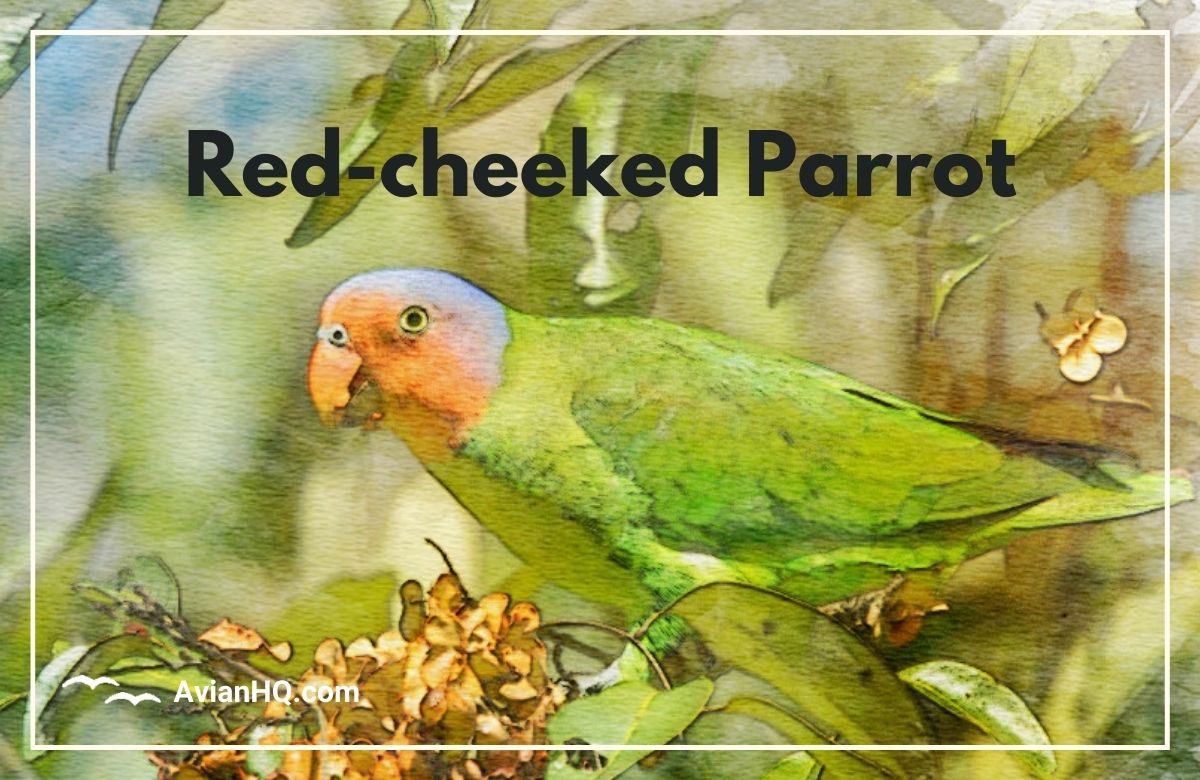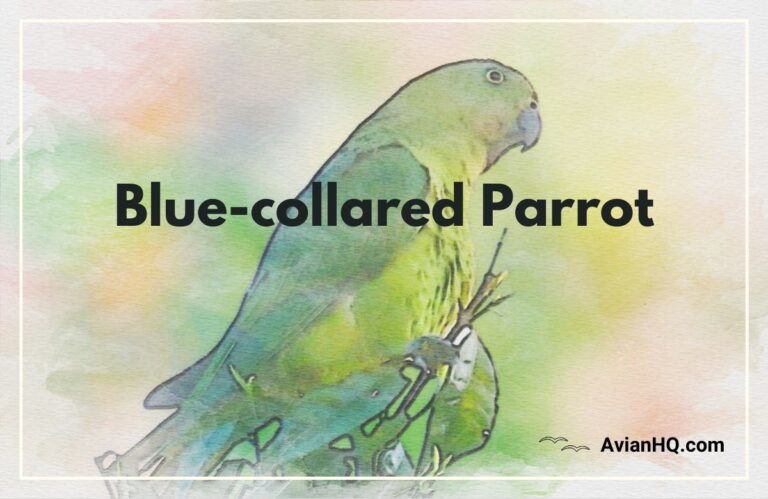Red-cheeked Parrot (Geoffroyus geoffroyi)
The brilliant plumage and cheeky character of the Red-cheeked Parrot make it one of the most charming birds found in Indonesia, Papua New Guinea and the tip of northern Australia. With emerald green feathers accented by a scarlet forehead and blushing red cheek patches, these parrots captivate bird enthusiasts and nature lovers alike.
Yet beyond its superficial beauty, the Red-cheeked Parrot is a fascinating species with complex behaviors and adaptations. Once you learn about these birds, you’ll understand why conservationists have noted their dwindling populations as a concern.
This article will give you a comprehensive overview of the Red-cheeked Parrot, exploring everything from its history to modern-day threats to its survival. You’ll learn about the bird’s distinctive appearance, social habits, breeding behaviors, habitat needs, and current conservation status. By the end, you’ll have a deeper appreciation for this intriguing parrot.
Whether you’re an avid birder eager to add Geoffroyus geoffroyi to your life list, or simply love learning about the wonders of the natural world, read on to uncover the story of the Red-cheeked Parrot.
History
The Red-cheeked Parrot was first scientifically described in 1788 by the German naturalist Johann Friedrich Gmelin. He named it Psittacus geoffroyi after the French zoologist Étienne Geoffroy Saint-Hilaire.
In the early 1800s, further taxonomic review assigned it to the genus Geoffroyus that bears Saint-Hilaire’s name. Its species name geoffroyi honors his contributions to ornithology.
For years, the Red-cheeked Parrot was considered a subspecies of the Blue-collared Parrot (Geoffroyus simplex). But in 1976, it was demonstrated there were distinct differences in morphology, vocalizations, and behaviors that justified designation as a full species, Geoffroyus geoffroyi.
Ornithologists long thought the parrot was restricted to the island of Guadalcanal. But field surveys in the 1960s and 70s revealed a broader distribution across the Solomon Islands chain, Indonesia and Norther Australia. Collection of the first live specimens outside Guadalcanal occurred in the 1950s.
Much of the ecology and behavior of this shy canopy species remained unknown until thorough field studies were conducted in the 1980s by scientists. This expanded knowledge of the Red-cheeked Parrot’s natural history and conservation needs.
Physical Appearance
The Red-cheeked Parrot is a medium-sized parrot measuring around 21cm (8.2 in) long and weighing 135-180g (4.7-6.3 oz). It has a stocky build with a short tail and a large head and beak relative to its body size.
The bright green plumage on the upper body and wings provides camouflage within the rainforest canopy. The lower breast and belly feathers are a paler greenish-yellow. As the name suggests, distinctive scarlet patches occur on the forehead and cheeks. The lower cheeks and throat are tinged with blue. The eyes are brown, the upper beak is coral-pink and the lower beak is brown-grey and the legs are gray.
Male and female red-cheeked parrots have identical external appearance or sexual monomorphism. Juveniles can be identified by their duller plumage and dark striping on the head. After the first molt, they attain adult coloration.
Unique field marks for this species include the eponymous red cheeks as well as the bright crimson upper-tail coverts under the wings, visible only during flight.
Habitat and Distribution
The Red-cheeked Parrot is found in northern Australia, Indonesia, East Timor, and Papua New Guinea. Its range extends across Cape York Peninsula, the Lesser Sunda Islands including Timor and Wetar, and several other islands in the region.
This parrot inhabits a variety of forested habitats including subtropical or tropical dry forests, tropical moist lowland forests, and mangrove forests near streams and coastlines.
In Australia, it is mostly restricted to the ironbark and melaleuca woodlands of eastern Cape York Peninsula. In New Guinea and nearby islands, it occupies both primary and secondary lowland rainforests up to 1,000 m (3,300 ft) elevation.
Mangrove forests are also utilized, especially where they border freshwater streams. The parrot has adapted readily to some human-modified landscapes such as cultivated fruits orchards interspersed with forest patches.
Across the fragmented range, conservation threats and population trends can vary locally. But habitat loss remains the overarching concern for the Red-cheeked Parrot’s long-term survival.
Diet and Feeding
The Red-cheeked Parrot is predominantly frugivorous, feeding on a variety of fruits, seeds, nectar and blossoms. Favored food sources include figs, the fruits and seeds of trees like Corymbia papuana, Casuarina papuana, and the scaly ash Ganophyllum falcatum. They also forage for banana, apple, pear, orange and other cultivated fruits. Nectar from blossoms provides an important supplemental food source. Their brush-tipped tongues are adapted for lapping nectar.
When foraging, they gather conspicuously in large, noisy flocks. They mainly use their feet for perching and only walk short distances between trees.
In captivity, these parrots can be fed a diet including sprouted seeds, lory nectar, softened rusk or biscuits, small amounts of millet and oats, and vitamin-enriched pellets.
Breeding and Reproduction
Red-cheeked parrots usually live in pairs or small family groups outside of breeding season. There is limited information known about their courtship behaviors in the wild.
During breeding season, they are generally found in pairs. The female excavates a nest cavity in a rotting tree limb, where she lays a clutch of 2-4 eggs. The white eggs measure approximately 29 x 25 mm (1.1 x 1 in) and weigh 8-10 g (0.28-0.35 oz).
The breeding season varies across their range: April-August in the Lesser Sunda Islands, February-October in New Guinea, and August-December in Australia.
There is no definitive data on the incubation period or age at fledging. It is presumed the female incubates the eggs and broods the chicks, with the male providing food, similar to related parrots.
Further research is needed to better understand the nesting habits, parental roles, and developmental timelines of wild Red-cheeked Parrot chicks. Their elusive nature makes gathering breeding data challenging.
Behavior
Red-cheeked Parrots exhibit typical parrot behaviors but also have some interesting idiosyncrasies.
They are active and noisy birds, spending most of the daylight hours foraging, preening, or interacting vocally. Calls include loud screeches, chatter, contact calls, mimicry of other birds, and the “burra-burra” alarm call.
Though sociable, they may squabble over choice perches and food resources. Flocks display synchronized movements and rotations of activities. Pairs preen each other to bond.
Red-cheeked parrots bathe frequently by fluttering in rain showers. They remove parasites by scratching with their feet and rubbing against branches.
At night, they roost communally in cavities up to 100 birds. Predators include falcons, accipiters, snakes, and monitor lizards. The parrots are wary and flee rapidly when disturbed.
Cool behaviors include play activities like hanging upside down, passing sticks, and practicing flying. Juveniles beg and jostle for food by pushing each other with their bills.
Conservation Status and Threats
The Red-cheeked Parrot is classified as Least Concern on the IUCN Red List. However, habitat loss and trapping for the pet trade are the threats facing the species.
Over the past decades, lowland rainforest acreage has declined over 50% across the red-cheeked parrot’s range. Logging, mining, agriculture and infrastructure development have degraded and fragmented suitable habitat.
These parrots are popular cage birds and hundreds are trapped illegally each year for the domestic and international pet trade. Nest poaching also occurs, reducing reproductive rates.
Predation by invasive species like rats and feral cats is also a concern in some areas. Vulnerability is compounded by the restricted home range less than 20,000 km2 (7,700 mi2).
Conservation actions needed include habitat protection, anti-poaching efforts, captive breeding programs, and local community engagement. But the inaccessible terrain makes enforcement difficult.
Conclusion
The Red-cheeked Parrot is truly a jewel of of a bird. Its vibrant plumage and charismatic nature have captivated people worldwide, but have also fueled illegal trade threatening its future.
As human activities continue to encroach on its specialized habitat needs, conservation action is crucial. Protecting sufficient old-growth rainforest acreage, limiting trapping, and community engagement will give these parrots the best chance.
With appropriate habitat and reduced poaching pressure, the species can thrive. The resilience of the Red-cheeked Parrot over thousands of years is remarkable. But its survival now depends on human choices.
By supporting responsible ecotourism, sustainable development and anti-poaching efforts in the Indonesia, Papua New Guinea area, we can secure the longevity of these parrots. Their beauty and behaviors deserve to be appreciated in the wild for generations to come.
The Red-cheeked Parrot’s fate lies in our hands. With commitment to conservation, this fascinating species can be preserved for the future. The time to act is now.





